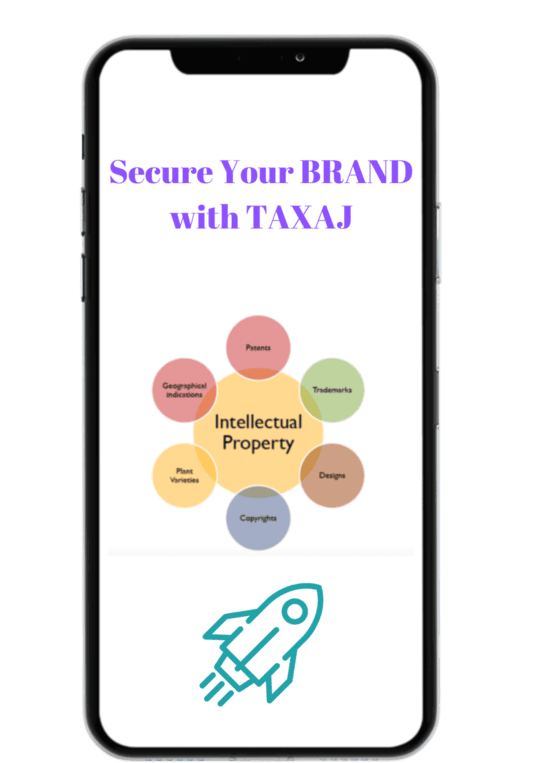Intellectual Property Rights
Intellectual property is a category of property that includes intangible creations of the human intellect. There are many types of intellectual property, and some countries recognize more than others. The most well-known types are copyrights, patents, trademarks, and trade secrets. Intellectual property rights are customarily divided into three major categories:

Trademark or Brand Registration
File trademark registration application online through TAXAJ in less than 24 hours at a nominal fee. Get a free trademark search and consultation on trademark filing process. TAXAJ provides a range of trademark services from trademark filing to objection handling.

CopyRight Registration
Obtain copyright registration online for books, music, film, photography and software applications through TAXAJ at a very nominal charges from sitting anywhere in India.

Patent Registration
Patent is an exclusive right for an invention provided by the law for a limited time to the Patentee. Easily file a patent application online on TAXAJ.

How it assists you?
Browse the full taxonomy structure of Goods and Services contained within the Harmonised Database and the classification databases of each of the participating offices.
Search for Goods and Services descriptions (terms) to determine the relevant class before applying for trademark protection as well as comparing terms contained in the databases of participating offices.
Verify if a list of Goods and Services in a given language appears in the database of a participating office with the same working language.
- Translate a term or a list of terms to obtain equivalents in the language of one of the participating offices.
What is a Trademark Class?
TMclass is a search tool for classification of Goods and Services for trademark protection purposes. It is the interface that provides access to the Harmonised Database (HDB), the EU common list of Goods and Services terms. It is also a portal that brings together the classification databases of all European and international participating offices, the names of which are displayed on the TMclass website.
TMclass offers a user-friendly environment with advanced features for browsing and searching terms, the possibility of verifying terms between the classification databases of Participating Offices, and multilingual functions for term translation.
What is Harmonised Database?
The HDB is a common list of Goods and Services terms accepted and implemented by all EU trademark offices. It consists of more than 78 000 terms that have been pre-validated by the EU National Offices and includes all terms from the Nice Alphabetical list. The HDB is the largest classification database in the world with all terms available in all official languages of the EU.
The HDB is a trusted source inside and outside of the EU; it is a live set of terms that is continuously updated and expanded. The harmonised workflow is based on democratic principles and transparent procedures whereby all the harmonised offices in the EU feed the database through a common application known as the Terminology Maintenance Console (TMC). This is achieved by proposing new terms for creation and proposing outdated terms for deletion. The harmonised workflow is based on a monthly cycle and ensures fully updated Goods and Services terms that reflect current market reality.
The development and expansion of the database also depends on collaboration initiatives with other IP organisations and the inclusion of classification lists such as the TM5 ID-list and the Madrid Goods and Services database (MGS) administered by WIPO.
Use of the Harmonised Database is a pre-requisite when registering trademarks via EUIPO’s Fast Track application procedure.
How does Trademark Class works?
The content of the Harmonised Database is organised in TMclass via a Taxonomy Tree structure. The Taxonomy is based on the 45 Class Headings of the Nice Classification, the international standard classification for Goods and Services. The TMclass Taxonomy is not an official part of the Nice Classification and does not have any legal effect in trademark examination or in the comparison of Goods and Services.
In the Taxonomy Tree the 45 Class Headings (1-34 Goods, 35-45 Services) are split into groups and in some cases into further subgroups. When browsing and searching for terms in TMclass, the classes will be displayed in a hierarchical structure showing the different levels of taxonomisation within each class.
The Taxonomy system aims to help with the classification process by allowing users to navigate intuitively through the classes to achieve more precision in their choice of terms.
The rights of authors of literary and artistic works (such as books and other writings, musical compositions, paintings, sculpture, computer programs and films) are protected by copyright, for a minimum period of 50 years after the death of the author.
Also protected through copyright and related (sometimes referred to as “neighbouring”) rights are the rights of performers (e.g. actors, singers and musicians), producers of phonograms (sound recordings) and broadcasting organisations. The main social purpose of protection of copyright and related rights is to encourage and reward creative work.
Industrial property can usefully be divided into two main areas:
One area can be characterised as the protection of distinctive signs, in particular trademarks (which distinguish the goods or services of one undertaking from those of other undertakings) and geographical indications (which identify a good as originating in a place where a given characteristic of the good is essentially attributable to its geographical origin).
The protection of such distinctive signs aims to stimulate and ensure fair competition and to protect consumers, by enabling them to make informed choices between various goods and services. The protection may last indefinitely, provided the sign in question continues to be distinctive.
Other types of industrial property are protected primarily to stimulate innovation, design and the creation of technology. In this category fall inventions (protected by patents), industrial designs and trade secrets.
The social purpose is to provide protection for the results of investment in the development of new technology, thus giving the incentive and means to finance research and development activities.
A functioning intellectual property regime should also facilitate the transfer of technology in the form of foreign direct investment, joint ventures and licensing.
The protection is usually given for a finite term (typically 20 years in the case of patents).
While the basic social objectives of intellectual property protection are as outlined above, it should also be noted that the exclusive rights given are generally subject to a number of limitations and exceptions, aimed at fine-tuning the balance that has to be found between the legitimate interests of right holders and of users.
Decision making
Even if you don’t realize it, everyone deals with trademarks on a daily basis. “Trademark” is another way of referring to brands.
Consumers’ purchasing decisions are influenced by trademarks and the reputation such brands represent. It is important for business people to have an understanding of why trademarks are important assets and help grow their business. Here are the seven top reasons of why trademarks are important to your business.
Start a Business
7 Reasons Why Trademark is Important
1. Trademarks are an effective communication tool.
In a single brand or logo, trademarks can convey intellectual and emotional attributes and messages about you, your company, and your company’s reputation, products and services.
Your trademark doesn’t need to be a word. Designs can be recognised regardless of language or alphabet. The "TAXAJ or "Nike" or “Swoosh” design is recognised globally, regardless of whether the native language is Swahili, Chinese, Spanish, Russian, Arabic or English.
2. Trademarks make it easy for customers to find you.
The marketplace is crowded and it’s hard to distinguish your business from your competitors. Trademarks/brands are an efficient commercial communication tool to capture customer attention and make your business, products and services stand out. Customers viewing a trademark immediately know who they are dealing with, the reputation of your business and are less likely to look for alternatives. Your brand could be the critical factor in driving a customer’s purchase decision.
3. It allow businesses to effectively utilize the Internet and social media.
Your brand is the first thing customers enter into a search engine or social media platform (Facebook, Twitter, Pinterest) when looking for your products and services. Higher traffic on a website or social media platform translates into higher rankings, bringing even more traffic, more customers and more brand recognition.
4. Trademarks are a valuable asset.
Trademarks can appreciate in value over time. The more your business reputation grows, the more valuable your brand will be. Trademarks provide value beyond your core business. Trademarks can lead the way for expansion from one industry to another, such as from personal care to clothing or eye ware. If you desire it, your trademark can lead to the acquisition of your business by a larger corporation.
Trademarks are a property asset, similar to real estate, that can be bought, sold, licensed (like renting or leasing) or used as a security interest to secure a loan to grow your business.
5. Trademarks can make hiring easier.
Brands can inspire positive feelings in people’s minds. As a result, employment opportunities are more attractive to candidates. Employee retention can be higher if employees have positive feelings for the brand and the products and services offered.
6. Trademarks are a bargain to obtain
The Intellectual Property Authorities charges as little as INR 5000 to obtain trademark registration.
7. Trademarks never expire.
Your trademark will not expire as long as you are renewing it every 10 years. Some of the most recognised brands in the India have been around for over a hundred years. Mercedes was first registered in 1900. Pepsi-Cola was registered in 1896.
Brands are a critical asset. Do your due diligence before investing a lot of time and money in launching a new brand.
Be sure the brand fits your company. Obtain a clearance search to make sure your new brand is available and doesn't infringe on anyone’s prior rights. Failing to research a brand before adopting can lead to denial of registration by the USPTO or, worse, a cease and desist letter from another brand owner. Spending the time and money up front to determine whether a brand is available will help avoid the very high costs of a dispute or litigation.
Keep in mind that the more you differentiate your brand from others in your industry, the easier it'll be to protect. Choose a name and logo that distinctly identify your business and will protect it from competitors.
TAXAJ can help you register your brand in merely few clicks and you can stay tension free.

